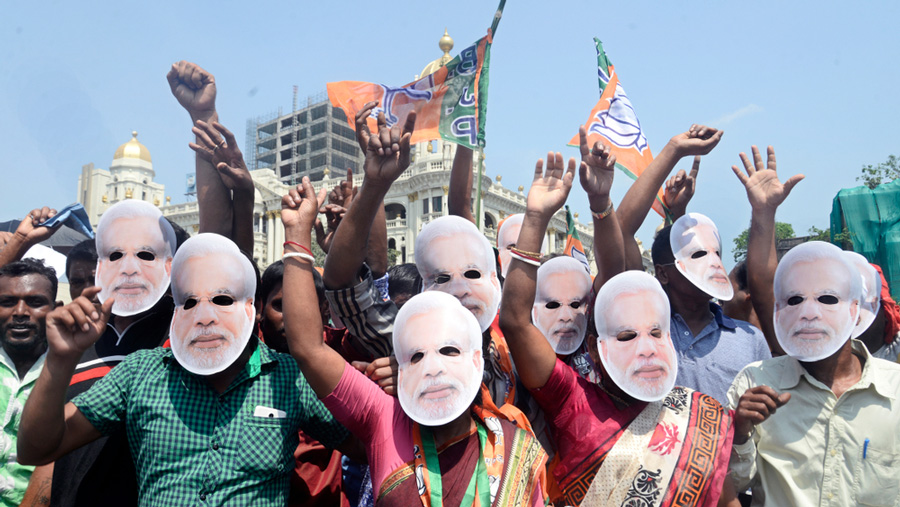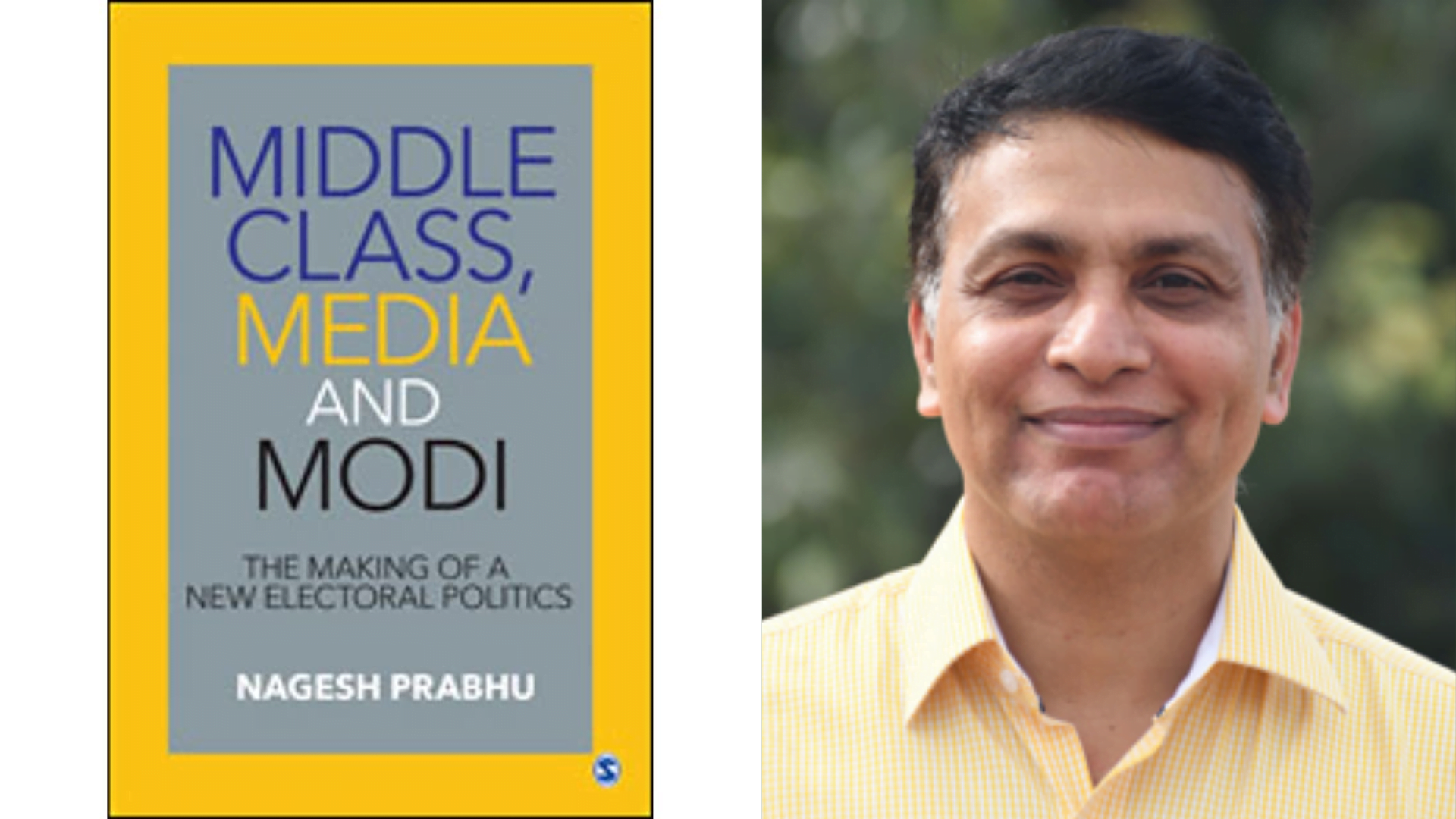The 2014 Lok Sabha elections in India opened up political analysis on multiple new aspects in the Indian context. The extensive use of social media, employing specific agencies to help with IT and electoral mapping, the role of the Election Commission, the amount of money spent for campaigning (which almost rivalled that of the U.S. Presidential campaign) – all of these were seen in a new light as their importance and implications grew by leaps and bounds.
Nagesh Prabhu’s ‘Middle Class, Media and Modi’ is a timely intervention that puts forward a theoretical and historical context and shows how Narendra Modi and the BJP smartly managed the middle class and the media to win the elections twice.
If a layperson was asked to list all the factors that influenced NDA’s win in the 2014 and 2019 elections – they would probably recount the same things as mentioned above. However, a detailed analysis was long missing about why each of these factors worked in favour of the Bharatiya Janata Party, which ultimately gave them the win. Along with that, the most ubiquitous but invisible factor – the role of the middle class is also not studied enough. Nagesh Prabhu’s ‘Middle Class, Media and Modi’ is a timely intervention that puts forward a theoretical and historical context and shows how Narendra Modi and the BJP smartly managed the middle class and the media to win the elections twice.

Also read: 5 Convenient Lies The Indian Middle Class Tells Itself After Every Outrage
‘Middle Class, Media and Modi’ starts with an excellent theoretical introduction about the middle class and its size, constituents and role in the economy. The impressive research done by the author will be of use to anybody who is interested in Political Science, Sociology and Political Economy as he contrasts and compares theories about middle class given by various authors ranging from Francis Fukuyama to Samuel Huntington. He also talks about the different approaches to study the middle class given by Karl Marx and Max Weber in ‘Middle Class, Media and Modi’ – all of which helps in understanding the significance of the middle class with respect to the strength of democracy and economy in a country.
After establishing the importance of the middle class, ‘Middle Class, Media and Modi’ traced the historical origin of the Indian middle class from the British Raj to Post-Emergency period. The evolution of the Indian middle class in the colonial period was an important one – the English educated civil servant class who once looked up to the colonial rulers for their income and social mobility slowly turned into a class of dissatisfied educated elites who wanted the right to rule their own land. With the creation of the Indian National Congress, there was a clear contrast between the elite minority of the middle class and the rest of Indian population.
With independence, the role of the middle class in India expanded due to Nehru’s policies which aimed to uplift them even more. ‘Middle Class, Media and Modi’ argues how the middle class also played an unusual role during the emergency as they supported Prime Minister Indira Gandhi’s reforms and actions – in a way, the middle class looked after the protection of their own interests.
However, in the 1990s during the era of liberalisation, the Indian middle class was effectively divided into two factions – the old and the new (or neo) middle class. The author of ‘Middle Class, Media and Modi’ does a comprehensive task of describing the new middle class and their aspirations, which ultimately influences who they vote for. The new middle class comprises of mostly young people who are employed in the IT sector and have a completely different lifestyle. The new middle class in the urban sphere is also more caste conscious and religious than their rural counterparts. With the new middle class growing in size along with their access to social, visual and print media, they became a decisive vote bank for the elections, particularly in the tumultuous election of 2014.
In the next chapters of ‘Middle Class, Media and Modi’, the author shows how the BJP slowly proved itself to be a viable alternative to the Congress-UPA government that was mired in controversies of corruption, dynastic politics and economic stagnation. From its excessive emphasis on ‘Swadesi’ products, the BJP changed its image to become a proponent of liberalisation, investments and “minimum government, maximum governance”. The new middle class could identify with the goals BJP set for the development of India, they also found an inspirational leader in Narendra Modi who had brought development to his own state, Gujarat and was widely known as a taskmaster. Modi’s speeches about handling corruption, bringing in development and dealing with Pakistan and terrorism struck a chord with the aspirational middle class who were also simultaneously under the influence of soft Hindutva nationalism. Modi also gave speeches in almost every part of India where he also made regional references that helped extend his appeal as a national political figure who could be trusted and depended upon. ‘Middle Class, Media and Modi’ also notes the contentious relationship between Modi and journalists, and how he did not address a single press conference during his tenure as Prime Minister in 2014-2019.
The final chapter in ‘Middle Class, Media and Modi’ about social media tries to make sense of how websites and applications like WhatsApp, Facebook and Twitter were used extensively by the BJP to extend their appeal and reach out to a huge mass. Narendra Modi himself was quite astute in understanding the importance of social media and had a website and Twitter, Facebook accounts even before Rahul Gandhi joined Twitter. There have been repeated problems regarding online trolling of anti-BJP journalists or activists, or even spreading of misinformation which has led to mob lynching in India, yet social media remains an important tool in elections, with its importance only set to increase in the coming years.
Also read: Yoga-tta Be Kidding Me: Capitalism and Gaslighting in Modi’s India
The narrative of ‘Middle Class, Media and Modi’ at times feels too neutral and detached as the “achievements” of the NDA government are listed without any critique about them. It almost gives an impression that the “achievements” seem to have happened in isolation without any consequences or impact upon the lives of the common people of India.
The narrative of ‘Middle Class, Media and Modi’ at times feels too neutral and detached as the “achievements” of the NDA government are listed without any critique about them. It almost gives an impression that the “achievements” seem to have happened in isolation without any consequences or impact upon the lives of the common people of India. The book also runs the risk of becoming too repetitive at times (such as while stating why the UPA government failed or why people stopped putting their faith in them), however that may be construed as a literary tool to re-emphasise upon the readers the exact lacuna where the UPA government failed and the BJP capitalised upon. The events in ‘Middle Class, Media and Modi’ are updated till the earlier part of 2020, so the political events after that (the poor management of returning migrant workers or the Chinese invasion) which are so fresh in every Indian’s mind are naturally not addressed here leading to a sense of dissonance.
‘Middle Class, Media and Modi’ remains a timely intervention as it looks into the role of the middle class and the media from the perspective of BJP and Narendra Modi – thereby, showing the readers what worked in their favour and what did not. It is also a valuable addition to books about Indian politics in the recent past due to its contribution towards highlighting the importance of newly emerging factors which were previously ignored.
About the author(s)
Sukanya Bhattacharya is a postgraduate student at Tata Institute of Social Sciences, Mumbai. She is interested in looking at feminism and gender through the lenses of popular culture, social media and urban spaces. She has written for 'Asia in Global Affairs' and has also been a volunteer at 'Calcutta Rescue'. She is also an avid debater and a quizzer.




